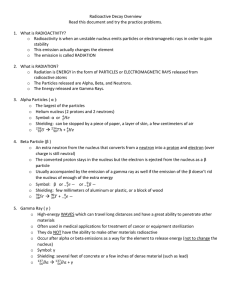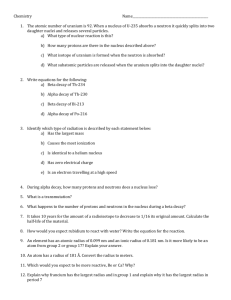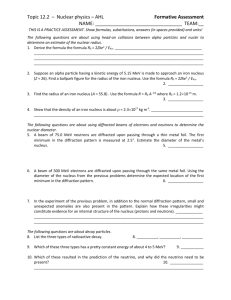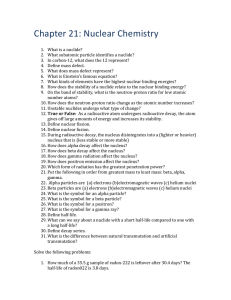NUCLEAR CHEMISTRY
advertisement
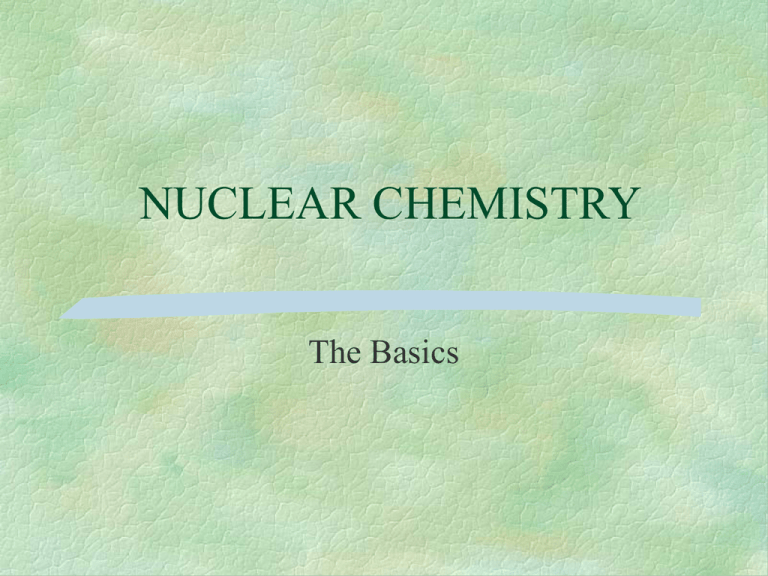
NUCLEAR CHEMISTRY The Basics The Nucleus • The nucleus is composed of nucleons – protons – neutrons • A nucleus is characterized by two numbers – atomic mass number(A; total # of nucleons) – atomic number (Z; number of protons) A Z E 27 13 Al • total number of nucleons is 27 • total number of protons is 13 • the number of neutrons is 14 Subatomic Particles one atomic mass unit (u) is defined as 1/12th the mass of a carbon-12 atom Particle electron proton neutron mass in kg 9.11 x 10 -31 kg mass in u -4 5.485 x 10 u 1.673 x 10 -27 kg 1.0073 u 1.675 x 10 -27 kg 1.0087 u Mass Defect • • • • Carbon-12 has a mass of 12.000 u Its nucleus contains 12 nucleons (6 p & 6n) Each nucleon has a mass >1 u The mass of a nucleus is slightly less than the mass of the individual nucleons • The missing mass is called the mass defect • mass defect:m = mass nucleons - mass nucleus Einstein’s Equation • Energy and mass can be interconverted • E = mc2 • When protons & neutrons are packed together to form a nucleus, some of the mass is converted to energy and released • This amount of mass is equal to the force of attraction holding the nucleons together Einstein’s Equation • The total energy required to break up a nucleus into its constituent protons & neutrons • binding energy = mc2 • The nuclear binding energy is measured in MeV which is much larger than the few eV required to hold electrons to an atom Binding Energy Curve • graph peaks at A=56 • the more BE released per nucleon, the more stable the nucleus • mass number of 56 is maximum possible stability § Theoretically, all nuclei will try to become larger or smaller to attain as mass number of nucleons § To the right of 56 => want to become smaller § To the left of 56 => want become larger How Many Neutrons? § The number of neutrons in a nucleus can vary § Range limited by the degree of instability created by having too many neutrons too few neutrons § Stable nuclei do not decay spontaneously § Unstable nuclei have a certain probability to decay Nuclear Stability Facts § 270 Stable nuclides § 1700 radionuclides § Every element has at least one one radioisotope § For light elements (Z20), Z:N ratio is ~1 § Z:N ratio increases toward 1.5 for heavy elements § For Z>83, all isotopes are radioactive Nuclear Stability Facts § The greater the number of protons, the more neutrons are needed § “Magic numbers” of protons or neutrons which are unusually stable 2, 8, 20, 28, 50, 82, 126 • Sn (Z=50) has 10 isotopes; In (Z=49)& Sb (Z=51) have only 2 • Pb-208 has a double magic number (126n, 82p) & is very stable Band of Nuclear Stability § A plot of the known isotopes on a neutron/proton grid gives § Stable isotopes form a band of stability from H to U § Z:N ratios to either side of this band are too unstable & are not known Nuclear Band of Stability Radioactivity • The spontaneous decomposition of an unstable nucleus into a more stable nucleus by releasing fragments or energy. • Sometimes it releases both. Electromagnetic Radiation § Electromagnetic radiation is a form of energy that can pass through empty space § It is not just a particle, and it is not just a wave. It may be both. Electromagnetic Radiation § The shorter the wavelength, the more energy it possesses § gamma rays are very energetic § radio waves are not ver energetic Some Types of Radioactive Decay • Alpha Decay (increases N:Z ratio) • Beta Decay (decreases N:Z ratio) • Gamma Decay Alpha Emission • ZAX Y + 2 Z-2 • Identity of the atom changes 235 231 4 • 92 U Th + 90 2 • Quick way for a large atom to lose a lot of nucleons A-4 4 Beta Emission • Ejection of a high speed electron from the nucleus A -1 • ZAX Y + Z+1 0 40 40 -1 • 19 K Ca + 20 0 • Identity of atom changes Gamma Emission • Emission of high energy electromagnetic radiation • Usually occurs after emission of a decay particle forms a metastable nucleus • Does not change the isotope or element Radiation Energetics § Alpha Particles relatively heavy and doubly charged lose energy quickly in matter § Beta Particles much smaller and singly charged interact more slowly with matter § Gamma Rays & X-rays high energy more lengthy interaction with matter Hazards of Radiation Types § Alpha Emissions easily shielded considered hazardous if alpha emitting material is ingested or inhaled § Beta Emissions shielded by thin layers of material considered hazardous is a beta emitter is ingested or inhaled § Gamma Emissions need dense material for shielding considered hazardous when external to the body Radioactive Decay Rates § Relative stability of nuclei can be expressed in terms of the time required for half of the sample to decay § Examples: time for 1 g to decay to .5 g Co-60 Cu-64 U-238 U-235 5 yr 13 h 4.51 x 109 yr 7.1 x 108 yr Half-Life The time required for half of a sample to decay Half-Life § The level of radioactivity of an isotope is inversely proportional to its half-life. The shorter the half-life, more unstable the nucleus § The half-life of a radionuclide is constant § Rate of disintegration is independent of temperature or the number of radioactive nuclei present Half-Life Number of Half-Lives Fraction of Initial Amount Remaining Amount Remaining (mg) 0 1 2 3 4 5 1 1/2 1/4 1/8 1/16 1/32 20.00 (initial) 10.00 5.00 2.50 1.25 0.625 Half-Life § A plot the logarithm of activity vs. the time is a straight line. § The quantity of any radioactive element will diminish by a factor of 1000 during a 10 half-life span Trying To Reach Nuclear Stability § Some nuclides (particularly those Z>83) cannot attain a stable, nonradioactive nucleus by a single emission. § The product of such an emission is itself radioactive and will undergo a further decay process. § Heavy nuclei may undergo a whole decay series of nuclear disintegrations before reaching a nonradioactive product. Decay Series A series of elements produced from the successive emission of alpha & beta particles The Four Known Decay Series Parent Radioisotope # of Decay Steps Final Product of Series Uranium-238 14 Lead-206 Thorium-232 10 Lead-208 Uranium-235 11 Lead-207 Plutonium-241 13 Bismuth-209 The Radon Story Radon-222 § Originates from U-238 which occurs naturally in most types of granite § Radon-222 has a half-life of 3.825 days § It decays via alpha emissions § This isotope is a particular problem because it is a gas which can leave the surrounding rock and enter buildings with the atmospheric air





